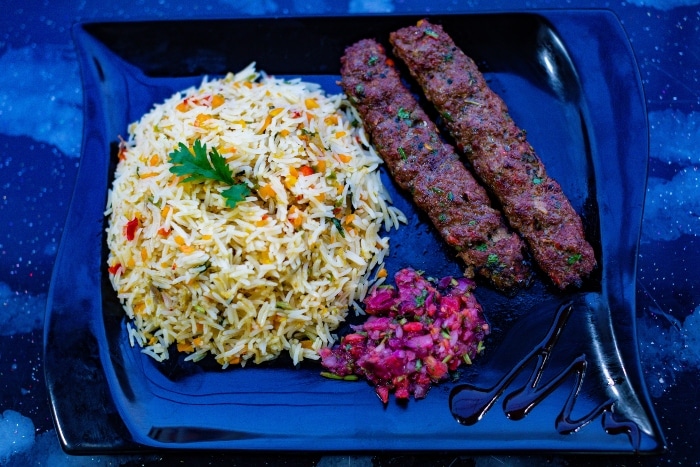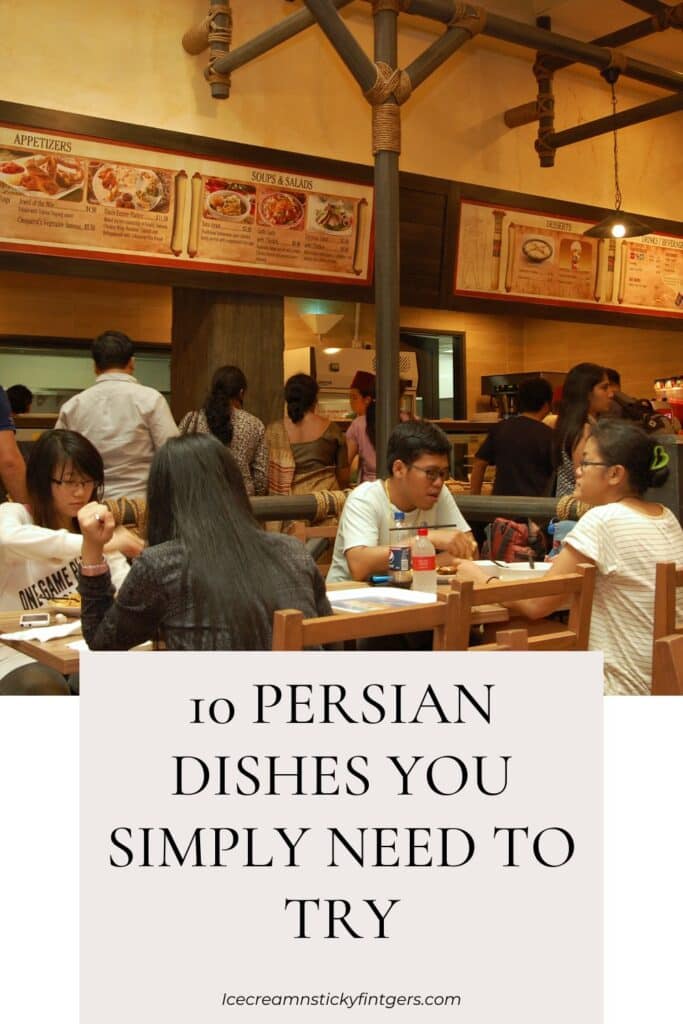Have your taste buds grown bored of your typical cuisine? Craving something exotic and flavorful to awaken them? Then you need to discover these 10 Persian dishes you simply need to try. Iran’s culinary offerings are a feast for all the senses, with vibrant spices, fragrant rice, and sauces to die for.
You may think you know Persian food from eating kebabs at your local restaurant, but there’s a whole world of delicious dishes waiting to be explored. With these Persian dishes you simply need to try, your taste buds will never be the same. What are you waiting for? A whole new flavor adventure awaits.

Fesenjan (Pomegranate Walnut Stew)
This rich, tangy stew will awaken your taste buds. Made with pomegranate molasses, walnuts, and your choice of meat (chicken, duck, or lamb are common), fesenjan has a complex savory-sweet flavor.
To make fesenjan, sauté diced onions until soft, then add ground walnuts, pomegranate molasses, and spices like cinnamon and turmeric. Simmer until thickened, then add your meat of choice and cook until the meat is tender.
- Serve fesenjan with chelow, saffron rice, or bread to soak up the flavorful sauce.
- Pomegranate molasses, made from reduced pomegranate juice, gives fesenjan its distinctive tart-sweet kick. Find it at Middle Eastern grocers or substitute equal parts honey and lime juice.
- Crushed walnuts provide richness, body, and protein. For a crunchy garnish, reserve a few whole walnuts to sprinkle on top.
This royal dish has been beloved for centuries in Persian palaces and homes alike. With its balance of savory, sweet, and tangy flavors, fesenjan makes for a memorable meal.
Kabab Koobideh (Kebab)
A staple of Persian cuisine, kabab koobideh are grilled meatballs usually made from lamb or beef, minced and seasoned with onions and spices. They’re juicy, flavorful, and downright addictive.
To make koobideh, combine ground meat, minced onions, salt, and pepper. Add dried lime powder or sumac for tanginess and saffron for extra flavor. Mix in egg whites or yogurt to help bind the ingredients.
Form the mixture into oval shapes around skewers and grill over hot coals or gas, frequently turning, until the kebabs are browned, and the center is no longer pink. The key is not to overcook them, or they can become dry.
Koobideh is usually served with chelow rice, grilled tomatoes and bell peppers, yogurt, and a side salad. Wrap portions of the kebab and accompaniments in lavash bread with garlic paste for an extra special treat.
Tahdig (Crunchy Rice)
A beloved Persian dish, tahdig is the crispy, golden rice crust that forms at the bottom of the pot. To achieve the perfect tahdig, Iranians pour yogurt or egg yolks over saffron rice before steaming. As the rice cooks, the yogurt or eggs create a chewy, crusty layer. The key is not stirring the rice after adding the yogurt — let it sit undisturbed.
Once the rice is tender and the crust has formed, gently flip the entire rice cake onto a platter. The golden crust should remain intact. Tahdig is a delicacy and is often saved for guests or special occasions.
When done well, tahdig is a sublime combination of textures — fluffy rice and a crisp crust. Tahdig is comfort food at its finest, with each bite evoking memories of family, friends, and celebrations.
Baghali Polo (Rice With Dill and Fava Beans)
This colorful rice dish is flavored with dill and fava beans, giving it a burst of fresh herbaceousness. To make baghali polo, sauté minced garlic and onions, then add cooked rice, chopped dill, and fava beans. Mix well and season with salt, pepper, and turmeric. Some recipes also call for saffron to give it a vibrant yellow hue.Baghali polo is usually served alongside chelow kebabs or lamb chops. The fresh dill and fava beans pair perfectly with the meat’s richness. If you prefer a vegetarian option, fried or pickled vegetables are a great accompaniment. Baghali polo is a popular dish for Nowruz, the Persian New Year, as the green color of the dill and fava beans symbolizes springtime renewal.

Abgoosht (Meat Broth)
Abgoosht is a hearty Iranian stew made with lamb, chickpeas, potatoes, and tomatoes. To make abgoosht, lamb shanks or stew meat are simmered for hours with chickpeas and potatoes until the meat becomes fall-off-the-bone tender.
The resulting broth is deeply flavorful from the meat and vegetables. Traditionally, the solids are strained and served separately from the broth. The broth is seasoned with lime juice, dried lime powder, and mint. The solids are mashed and often mixed with yogurt or egg before being topped with sautéd onions and mint.
Abgoosht is usually eaten with lavash, sangak, or barbari bread to soak up the delicious broth. Some like to crumble the bread directly into the broth. Abgoosht is comfort food for sharing with family and friends.
Four Persian Desserts
Four Persian desserts you must try are baklava, faludeh, Bassani, and pashmak.
Sholeh Zard
Rice pudding, or sholeh zard, is comforting and creamy. Rice is simmered in milk with sugar, saffron, rosewater and chopped pistachios. The saffron gives it a golden hue and subtle floral flavor. Sholeh zard is usually eaten warm, but chilled leftovers are delightful too.
Faloodeh
Faloodeh is a chilled dessert of sweet starch noodles in rosewater syrup. The noodles are usually made from rice or wheat starch and colored red, green, or yellow. Faloodeh is light, refreshing, and not too sweet. It’s perfect for a hot summer day.
Bastani
Bastani is Persian saffron ice cream, rich, creamy, and aromatic. Rosewater and pistachios are also commonly added. Bastani is a popular street food in Iran, where vendors sell it from carts during warm summer evenings.
Pashmak
Pashmak is Persian candy floss or cotton candy. It’s made by heating and spinning sugar into fine threads. Pashmak comes in various bright colors and flavors, like saffron, rosewater, and berries. Light and airy, pashmak melts in your mouth.
Well, there you have it: 10 traditional Persian dishes that will take your taste buds on an exotic flavor adventure. From the citrusy koobideh kebabs to the saffron-infused below kebabs, your mouth will be left watering for more. The next time you’re craving something outside the norm, give one of these delicious dishes a try. You won’t regret discovering the vibrant tastes of Persian cuisine.

What are some Persian dishes you simply need to try that we didn’t mention here?






I don’t think I’ve had a lot of Persian food. I really should try them out because everything you mentioned sounds delish.
These all sound amazing. I sure want to give some of them a try.
We enjoy a lot of different cuisines, but I have to say I am not familiar with Persian food at all. This looks delicious and it would be fun to try out these dishes.
Baklava is the only thing on that list that I recognized. I love trying new things, though!
Each one sounds so delicious, and I would be willing to try them especially the Kabab Koobideh…it sounds like my kind of Persian cuisine…especially since I can use lamb meat.
You had me all the way through the post. I want to try all of these dishes!
This list seems like the perfect culinary roadmap. The way you describe the vibrant spices and fragrant rice dishes has me practically smelling and tasting them through the screen!
We love Persian food and make Tahdig often to accompany our vegetarian side dishes.. the desserts are awesome too
Reading about Fesenjan made my mouth water – that mix of pomegranate, walnuts, and savory meat sounds like an absolute flavor explosion.
Oh my gosh I love Persian dishes but I haven’t tried a lot of them. I love the Kebab!
I have very limited experience when it comes to Persian food though I do love koobideh. It’s from a favorite restaurant near my former office.
It all looks delicious. This is my first time knowing the food of Persian.